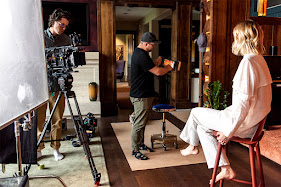In this documentary, I will be talking about the overall research on documentaries I did to learn more about this style of filmmaking. This research also helped me create my own piece, but we'll talk about that in a separate blog.
To start the topic of documentaries in my class, my teacher gave us basic notes on the simple aspects of documentaries we should be paying attention to when watching one. This not only included a description on what the purpose of a documentary is and how they try to show their message, but also specific conventions and techniques present in all documentaries. This included mainly production techniques but also included some post-production ones.
Examples on what we talked about:
-VO's and non-diegetic sounds
-Selective editing
-Interviews to progress the story
-Archived footage
-Lighting techniques
(and many more)
What I really liked about this lesson was how many new things I learned about a new genre and style of media for me. For example, I learned about what B-roll is, the importance of it in a documentary, and the process of collecting it while filming. I also learned about the type of interviews: direct, meaning you can hear and/or see the interviewer, and indirect, meaning you cannot hear nor see the interviewer. The different interview styles are also used for different styles and aspects they're trying to convey.
After this quick little lesson on the simple technical aspects of documentaries, as a class, we watched two full documentaries: American Promise and Exit Through The Giftshop.
I've got to be honest, I was never really interested in documentaries until watching these two.
American Promise was a documentary shot over 13 years on the two main subjects (Idris and Seun) on their life. The documentary started off by following the two young boys on their journey through 'The Dalton School' which is a high level school partnered with Ivy League schools. Closer to the end, the piece turned more into following what each of the boys were doing even after they grew apart and Seun left The Dalton School.
This documentary not only (in my opinion) was a great first choice to show the class, but also helped me ease into the new documentary mindset being implemented onto us. I think the main thing this documentary taught me was the growth and change a documentary should endure depending on everything within it.
For example, the main difference between the distinct types of interviews. At the beginning of the piece, when the boys were young, more direct interviews were being utilized as they couldn't yet understand how to properly restate and answer the questions adequately on their own. As for later in the documentary, almost no direct interviews were used (meaning only indirect) since the indirect interviews made the piece flow smoother together and offered more of a sideline standpoint instead of the idea that the boys were living differently for the camera. Indirect interviews were also used because they showed the growth and development of the abilities of both Idris and Seun as they grew up.
Exit Through The Giftshop was the second documentary we watched and it did not disappoint. I loved this piece so much. I think the completely different vibe and purpose of this documentary compared to American Promise made it so much more meaningful. Like American Promise, this film consists of many indirect interviews that make the piece flow better; however, the small number of direct interviews also play a part in adding context in difficult to understand situations.
This piece was also very unique due to the main focus of it. Although it was a documentary made by Banksy, most of it focuses on Thierry and his journey, especially since he began making the documentary on his own before handing it to Banksy. Banksy also made himself an anonymous subject with voice modifications and not showing his face. These aspects gave him a sense of no identity which adds to his rebellious and controversial art persona.
One big thing I learned from this piece is the importance of B-roll. B-roll plays such an important part in this documentary and without it, the film could never be the same. B-roll is used constantly throughout the piece to show examples, situations, past works, other graffiti, landscapes, and so much more. Most of the B-roll paired with a VO or a non-diegetic voice in the background that relates to the clips being shown (that also adds onto the overall storyline). The B-roll not only adds context in many situations but also allowed the viewers to see graffiti just like any other kind of art.
Whether they share many visual characteristics or not, both of these documentaries shared their deeper meaning of the piece: showing the evolution of the piece and its creation as it manipulates itself around the main subject/s changing and growing with the world around them.

For both of those examples, getting or finding B-roll filmed during the actual timing being talked about would be either impossible or nearly impossible; therefore, this piece utilized a lot of staged B-r0ll in order to fill the gaps between the years.
On our own time we also watched some Op-Docs which are very short documentaries about something. In my opinion, the only important lesson these taught me (at least from the ones I watched), is to just have fun with what you create. Not only make it fun to create, but also fun to watch. Whether the topic, the B-roll, the trials, etc., something has to be catching the audiences eye or ear and make them want to see the solution or final claim of your documentary,
Overall, I believe that these three (specific ones, not including Op-Docs) documentaries were what mainly helped me through my introduction and understanding of documentaries as a whole. They each reached different categories but many had deeper conjoined meanings within.
-Dana








No comments:
Post a Comment